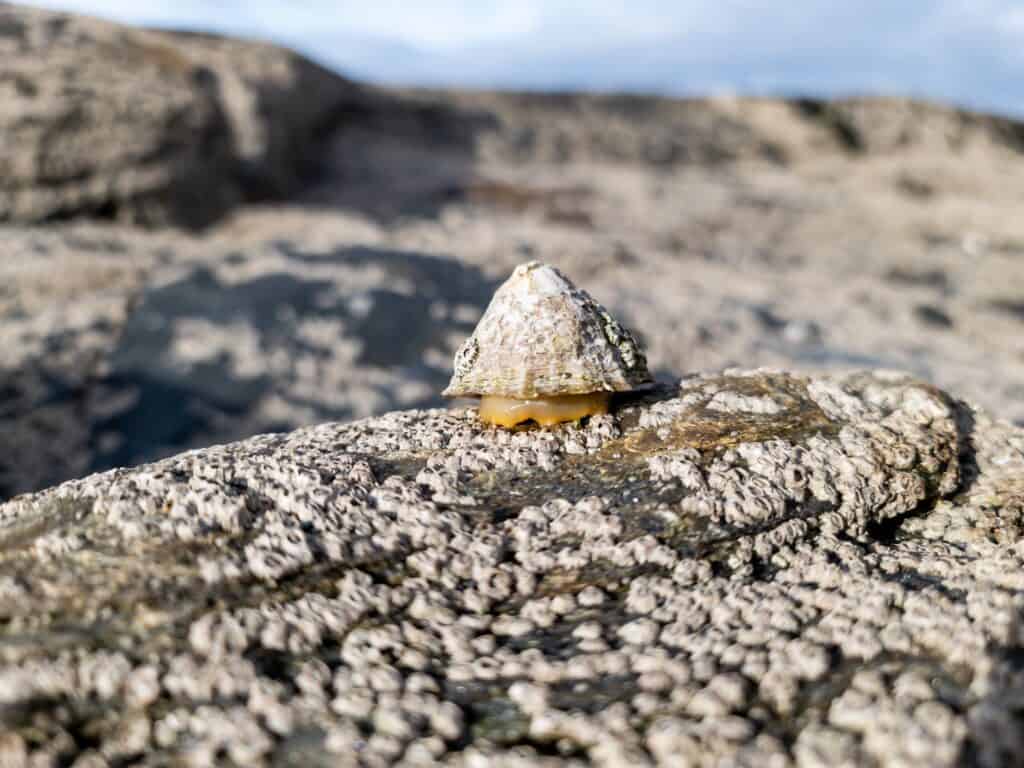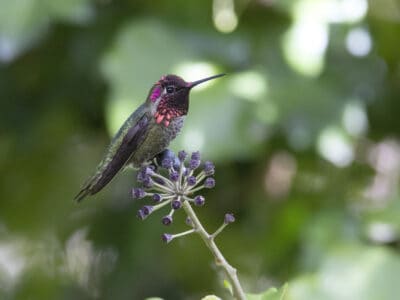Limpet
Can change sex from male to female and back again
Advertisement
Limpet Scientific Classification
Read our Complete Guide to Classification of Animals.
Limpet Conservation Status
Limpet Facts
- Name Of Young
- Larvae
- Group Behavior
- Solitary
- Fun Fact
- Can change sex from male to female and back again
- Biggest Threat
- Pollution and predators
- Most Distinctive Feature
- Conical shell
- Distinctive Feature
- Powerful tongue
- Habitat
- Intertidal zones and rocky shores
- Predators
- Birds, seals, crustaceans, starfish, otters
- Diet
- Herbivore
- Lifestyle
- Nocturnal
- Favorite Food
- Algae
- Special Features
- Strongest teeth on earth
- Location
- Worldwide
View all of the Limpet images!
Summary
Equipped with the strongest teeth on Earth, limpets are aquatic snails in the class Gastropoda. They get their name from their dish-shaped, conical shell, which protects them from predators and tides. They possess extremely strong teeth and powerful tongues coated in adhesive mucus that they use to attach themselves to rocks.
5 Limpet Facts
- While those that live near algae only live for a few years, a limpet that lives on bare rock can live up to 16 years.
- Limpets will move around while feeding but usually return to a favorite spot to rest.
- A limpet’s anus is located in the nuchal cavity near its head, so it must compact its feces before a bowel movement to avoid fouling the cavity.
- Their teeth are the strongest known biological material with a tensile strength value nearly 13 times greater than steel.
- To reproduce, females and males release their eggs and sperm into the water through a process known as broadcast spawning.
Limpet Classification and Scientific Name
All are aquatic snails in the class Gastropoda. However, they are a polyphyletic group, which means that several unrelated species share the common name limpet. These groups all feature a conical shell shape but can otherwise belong to different orders and families. The scientific name for this shell shape, patelliform, means “dish-shaped, ” and derives from the Latin words patella, meaning “dish,” and iformes, meaning “the form of.” Although numerous species and groups go by this name, researchers recognize the clade Patellogastropoda as the “true limpets.” In particular, researchers distinguish species within the family Patellidae as a model group of true limpets. Moreover, the common limpet, Patella vulgata, is the type species of the type genus Patella in the family Patellidae.
Gastropods clades and families with species that share this common name include:
- Patellogastropoda- “true limpets”
- Vetigastropoda – keyhole limpets, slit limpets, and deepwater limpets
- Neritimorpha
- Heterobranchia – limpet-shaped umbrella slugs, false limpets, air-breathing limpets
- Neomphaloidea and Lepetodriloidea – hydrothermal vent limpets
- Hipponicidae – hoof snails
- Crepidula – slipper limpets
- Ancylidae – lake limpets
Limpet Appearance

Limpets will move around while feeding but usually return to a favorite spot to rest.
©Lukassek/Shutterstock.com
They can vary wildly in color, size, and shape. The one thing that all share in common is their conical shell. A common limpet’s shell comes in green, brown, gray, or white hues. The shell typically features several rows of ridges and straight lines that run from the tip of the cone to the edge of the shell. On average, limpet shells measure between 1 and 4 inches long and weigh from 0.2 to 8.4 grams. Inside the shell rests the snail’s body, which is also cone-like to fit the shape of the shell. The underside of its body consists of a muscular cushion known as the odontophore, which in turn supports the radula or tongue. They use their powerful tongues to scrape algae and seaweed off of rocks and other surfaces. The tongue directs food into the downward-facing mouth and into the esophagus.
Limpets possess hundreds of rows of sharp teeth, although only a few rows are dedicated to feeding. Their teeth are made from a mineral-protein composite, including iron, and are incredibly durable. With a tensile strength greater than spider silk and nearly 13 times stronger than steel, their teeth rank as the strongest known biological material in the world. Over time, they wear down their teeth but constantly replace them as they age. The teeth grow near the back of the radula and move forward over time, with each row getting replaced about once every 47 hours.
Limpet Digestion
Their digestive tract is incredibly long and makes up a large part of its total mass. They require an extra long digestive system and rectum to help them compact their fecal matter. Like other gastropods, limpets evolved to have a protective shell, but this added protection came at a price. As a result, their anus is located very close to their heads in a space known as the nuchal cavity. They must densely compact their feces to avoid soiling the cavity – and their head – with waste. A long digestive system aids in this process and allows them to maintain a healthy and clean living space.
Limpet Distribution, Population, and Habitat
You can find them all over the world in intertidal zones and along rocky shores. Most tend to be confined to specific geographic zones, although their range can extend for hundreds or even thousands of miles. For example, common limpets range throughout Western Europe, shield limpets (Lottia pelta) live across the Pacific Northwest from Alaska to Baja California, and Australian freshwater limpets (Ancylastrum cumingianus) live in freshwater lakes in the Central Plateau of Tasmania. During high tide, limits move around to feed but typically return to a favorite spot during low tide so they can secure and protect themselves from predators. Over time, the edges of the shell bore shallow grooves into the limpet’s favored spot. These spots are known as homescars, and they help them stay attached to rocks during low tide.
Limpets Predators and Prey
In the wild, several animals prey on this species. Their primary predators include crabs, lobsters, otters, seals, and starfish. During low tide, they must also contend with sea birds and lizards. Limpets have developed a number of adaptations to protect themselves from predators. Their shell serves as their first and most important form of defense. They attach themselves to rocks and other hard surfaces to protect their soft bodies using their powerful tongues and adhesive tongues. The suction created by the tongue and mucus can make limpets extremely difficult to remove, thereby preventing predators from getting around their protective shells. Meanwhile, some other species developed other methods to protect themselves. For example, the rough keyhole limpet (Diodora aspera) hosts the scale worm copepod (Anthessius nortoni). The limpet gives the copepod a home, while the copepod protects them by biting and warding off predatory starfish.
Limpets are nocturnal herbivores that primarily eat algae, seaweed, and other marine vegetation. They use their powerful tongues or radula to scrape algae off of rocks and other hard surfaces. During this process, they may sometimes also scrape young barnacles off of rocks and consume them. They tend to move around while feeding but will return to a preferred spot during the day to rest. Their feeding habits mean they serve an important role in maintaining the health of marine ecosystems as they control the rate of algae growth in the area.
Limpet Reproduction and Lifespan
Their sexual organs or gonads are located directly beneath the digestive system. When limpets are ready to reproduce, the gonads swell and burst, releasing either sperm or eggs into the surrounding water. The gametes float around in the water until they come in contact with the gametes of other limpets, and fertilization takes place. This process, known as broadcast spawning, is most effective when multiple limpets in the same area release their gametes at the same time. Their larvae freely swim around for a while until they eventually settle down onto a rock or other hard surface and develop into adults. Unlike most animals, they possess the ability to change their sex depending on the reproductive needs of the environment. While most limpets are born male, they can change from male to female as they grow, and some will even switch back to male.
In addition to affecting its sex, a limpet’s environment can significantly impact its life expectancy. Generally speaking, those that live in close proximity to large amounts of algae develop much more quickly. However, these limpets trade in a fast rate of development for a shortened lifespan. On average, those that live in close proximity to large amounts of algae only live for 2 or 3 years. Meanwhile, limpets that live on mostly bare rock can live up to 16 years, and some may live even longer.
Limpet in Food and Cooking
Today, they are not commonly used in cooking, although they are edible. However, historically limpets were eaten by many different people around the world. It’s encouraged to remove any dark, inedible parts first and to rinse away any sand or debris before cooking. The best way to clean and cook a limpet is to boil it in water. They lose their shells quickly under high heat and take only a few minutes to cook. One popular way to prepare them is to boil in water with pepper and anchovy sauce and then fry them in butter, vinegar, and pepper.
Alternatively, you can bake them either in or out of their shells. Some people prefer to remove them from the shell and tenderize them with a hammer first before baking or frying. This is because limpets are notoriously chewy, so tenderizing can help make them more palatable. Lastly, some people choose to eat them raw. Be advised that eating them raw can pose considerable health risks, particularly if they live in an area with high pollution levels.
Limpet Population
Overall, they are quite common and found nearly all over the world. They are extremely hardy and tend to adapt well to environmental changes and the effects of climate change. In fact, they may be particularly well situated to handle a warming climate. Warmer water can lead to increased algae growth. Increased algae provide more food for limpets to eat and can ensure more stable populations. While most limpet populations appear quite stable, a few are not faring as well. The ribbed Mediterranean limpet (Patella ferruginea) is native to the western Mediterranean sea. Until the past few decades, it used to be quite common, but it has become quite rare and is now only found in a few locations.
Related Animals
View all 98 animals that start with LLimpet FAQs (Frequently Asked Questions)
Are limpets carnivores, herbivores, or omnivores?
Limpets are nocturnal herbivores that primarily eat algae, seaweed, and other marine vegetation. That said, they may also consume young barnacles while scrounging for food.
Where are limpets found?
You can find limpets in intertidal zones and rocky shores around the world.
Can you eat a limpet?
While not widely eaten, limpets are edible when prepared properly and have historically been eaten by different cultures around the world.
What do limpets get eaten by?
Large crabs and starfish both prey on limpets as well as sea birds.
Thank you for reading! Have some feedback for us? Contact the AZ Animals editorial team.
Sources
- , Available here: https://australian.museum/learn/animals/molluscs/limpets/
- , Available here: https://www.americanoceans.org/species/common-limpet/
- , Available here: https://blogs.scientificamerican.com/extinction-countdown/the-incredible-mrmrs-limpet-the-endangered-sex-changing-sea-snail/
















